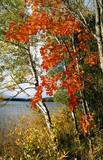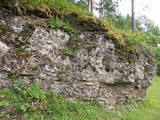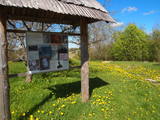| Nr | Name | Beschreibung |
|---|---|---|
|
Der Laden mit einem Café „Satikšanās vieta Skudras” befindet sich auf dem Fischmarkt in Ragaciems und bietet getrocknetes Fleisch, Fleisch- und Snackplatten sowie andere kulinarische Köstlichkeiten aus hausgemachten Produkten. Es ist ein Treffpunkt, wie es ihn seit langem auf einem Markt gibt, wo die Kunden die Produkthersteller und Anbauer treffen. In der warmen Jahreszeit ist eine Außenterrasse geöffnet. |
||
|
Sēlijā, pie Slates sila, atrodas "Kalnaleiskini". Saimnieks Mārtiņš Uzkurs ir galdnieks, bet sieva Lelde - dizainere abu kopējā galdniecības uzņēmumā un Latvijas Ornitoloģijas biedrības biedre ar pieredzi ekskursiju vadīšanā. |
||
|
Der Hof Vāldamō ist ein Wohnhaus mit einer gelblichen Färbung und einer natürlichen Dachdeckung, das am Anfang des 20. Jhs. als eine neue Wirtschaft gebaut wurde. Der Hof Virgo ist die nächste (nördlich) Wirtschaft hinter Vāldamō. Diese Wirtschaft wurde in den 1920er Jahren als eine neue Wirtschaft gebaut. Das Wohnhaus (1930) hat interessante Holzschnitzereien. Der Hof Fīlmaņi ist die nächste Wirtschaft (nördlich) hinter Virgo. Das altertümlich aussehende Haus wurde am Anfang des 20. Jhs. als ein Kleinzimmer gebaut. Den Hof Silkalni können wir finden, indem wir an der Kreuzung nach rechts – Richtung Pitrags – abbiegen. Der Hof ist ein Gebäude mit gelblicher Färbung, das um das Jahr 1906 als ein Kleinzimmer gebaut wurde. Der Hof Norpiedagi befindet sich südlich hinter dem Hof Silkalni. Das Haus hat braune Färbung und ist größer als das Haus des vorigen Hofes. Das Wohnhaus wurde um das Jahr 1906 als eine Kleinzimmer-Kornkammer von dem aktiven livischen gesellschaftlichen Mitarbeiter und dem Bootsbauer Didriķis Volganskis (1884 – 1968) gebaut. Im Jahr 1912 wurde hier sein Sohn Edgars Valgamā geboren, der auch ein livischer Kulturmitarbeiter war und in Finnland als Pfarrer gearbeitet hat. Der Hof Anduļi befindet sich an der vorher erwähnten Kreuzung, dieser Hof ist eine der größten Altwirtschaften und auch der älteste Hof des Dorfes, dessen Geschichte seit dem Jahr 1680 bekannt ist, als dieser Hof Kūkiņi genannt wurde. Zu dem Hof gehören das Wohnhaus (ungefähr 1909), die Getreidedarre (1905), die Kornkammer (Mitte des 19. Jhs.) und das Rauchhaus, das von einem durchsägten Boot gebaut worden ist. Unter der Getreidedarre von Anduļi, die auf einer Düne gebaut worden ist, befinden sich der mittelalterliche – der sogenannte Pestfriedhof. Der nächste ist der Hof Žoki, der sich gegenüber Anduļi und auf der anderen Seite des Weges befindet. Das heutige Haus ist auf den Fundamenten der historischen Altwirtschaft gebaut worden. In der Mitte des 19. Jhs. befand sich im Haus Žoki die erste Schule, in der den livischen Kindern das Lesen in den damaligen Küstendörfern von Dundaga beigebracht wurde. In dieser Schule arbeitete der Live Nika Polmanis (1823 – 1903). Der Hof Tilmači ist die nächste (nördlich) Wirtschaft hinter dem Hof Žoki. Hier haben sich mehrere Häuser erhalten, die in der Jahrhundertwende 19. – 20. Jh. gebaut worden sind: Das bräunlich gefärbte Wohnhaus, der Pferdestall und ein Teil der Kornkammer. Bei der Durchführung der Restaurationsarbeiten des Wohnhauses hat der Inhaber ein Brett mit der Aufschrift „1825. Gouvernement Kurland" gefunden. Die obengenannten sieben historischen Wirtschaften und Häuser waren vor einiger Zeit auch Kandidaten auf der Liste des UNESCO-Weltkulturerbes. |
||
|
The Lutheran Church of St John in Aizpute is on Beidas Hill, which is near the steep river valley of the Tebra River and the Dzirnavdīķis pond which the river has created. The church is on an ancient Courlandian castle hill. The current Gothic appearance of the church dates back to 1860, when it was rebuilt. The tower dates back to 1730. This is one of the oldest churches in Kurzeme, and it features an interesting interior with many artistic monuments. |
||
|
2006 wurde ein Pfad im Planču Moor angelegt. Vielleicht der einzige Naturpfad in Lettland, an dem auch ein Informationsstand in Blindenschrift vorgesehen ist.
|
||
|
Der Hof des Brauers befindet sich in einer der reizvollsten Gegenden von Litauen, die mit ihren Wäldern, Seen und Burghügeln auch als die litauische Schweiz bezeichnet wird. Das Bier der Marke Čižas ist leicht, ungefiltert und nicht pasteurisiert und nach dem Rezept der Großeltern mit Waldhonig hergestellt. Der Brauer hat nicht nur das Rezept geerbt, sondern auch das Zubehör und so hat er in seinem Hof eine Ausstellung mit altem Gerät zum Bierbrauen eingerichtet. |
||
|
Dieses Territorium schützt die Landschaft der Lielauce – Hügel, die ein Teil des Ostkurzemer Hochlandes sind. Die Seen Zebrus und Svēte befinden sich in diesem Gebiet. Am nordöstlichen Ufer des Zebrus – Sees kann man den Burgberg Ezerlūķi sehen. Am östlichen Ufer des Sees befinden sich eine Bootsstation sowie ein Aussichtsturm und einige Informationstafeln über das Gelände. Das Gebiet umfasst geschützte Biotope wie Sumpfflüsse und sumpfige Wälder mit geschützten Vögeln und Fledermausarten.
|
||
|
This is a farm of pedigree rabbits (11 breeds, ~200 rabbits). You can go on a tour of the farm and receive consultations on the breeding and selection of rabbits. You can also buy pedigreed rabbits for yourself. |
||
|
Der Gebrüderfriedhof von Lāčukrogs –
Friedhof für die im Ersten Weltkrieg
Gefallenen.
|
||
|
Ein einzigartiges Örtchen beiderseits des Flusses Minija, wo der Fluss eine „Hauptstraße” ist. Litauens Venedig. |
||
|
Der weiteste Nordpunkt der Juminda Halbinsel mit einer Raketen-Attrappe der Sowjetarmee, der alten Grabstätten, dem Juminda-Leuchtturm und einem Denkmal für die Opfern des Zweiten Weltkriegs. |
||
|
This park is located in the northern part of the Žemaitija Highlands, and much of it is taken up by Lake Plateliai. The park was established to protect lakes, rivers, wetlands and forest ecosystems, as well as the local cultural environment.
|
||
|
Abwechslungsreicher Pfad, der über einen Holzsteg entlang des Steilufers der Pilsupe bis zur Weißen Düne führt, die sich in der Zeit des Litorina Meeres vor einigen tausend Jahren gebildet hat. In der Umgebung wurden Überreste steinzeitlicher Siedlungen gefunden.
|
||
|
Die Wirtschaft Mazburkas befindet sich an einem landschaftlich schönen Ort zwischen der Straße Rīga – Ventspils (A 10) und Tukums. In der Umgebung der Wirtschaft kann man eine hügelige Landschaft genießen. An südlichen Abhängen der Hügel breiten sich Weintraubenfelder aus, wo ~60 Weintraubensorten gezüchtet werden. Besucher können Weintrauben kaufen oder diese im Garten selber pflücken. Aus Weintrauben macht die Wirtin ausgezeichnete Weine, die mit Preisen, darunter auch internationalen, ausgezeichnet sind. Der zweite Bereich der Spezialisierung der Wirtschaft ist Schafzucht. Interessenten können eine Schafherde besichtigen, sowie mit vorheriger Anmeldung auch Schaffleisch kaufen. Für Empfang von Gästen ist eine breite Plattform aus Holz gebaut worden. Die Wirtin Gunta Niedra teilt gerne ihre Erfahrung und gibt Ratschläge auch den Interessenten, die angefangen haben, Schafe zu züchten. |
||
|
Ainavisks, ap 340 m garš un līdz 15 m augsts atsegums, kas atrodas nepilnu kilometru lejpus Raunas ietekas Gaujā, kreisajā pamatkrastā. To veido sarkandzeltenīgi Gaujas svītas smilšakmeņi. Gar Kazu ieža austrumu daļas pakāji izkaisīiti vairāki lieli laukakmeņi, kas ērti iekārtojušies uz smilšakmeņos izskalotas pamatnes. |
||
|
Das ist ein Abschnitt des Gauja – Flusses mit Stromschnellen an einigen Stellen. Es erstreckt sich von Vidaga bis zum Ort, wo der Fluss Vecpalsa indie Gauja fließt. Entlang der Gauja und seinen Nebenflüssen kann man Dolomitaufschlüsse an seinen Ufern sehen, die größten sind die Randati – Klippen. Das Territorium wurde vor allem eingerichtet, um die verschiedenen Arten an Wald, Wiesen, Aufschlüssen und ihre Habitate zu schützen. Das ist ein interessanter Abschnitt des zentralen Teils der Gauja, vor allem für Leute, die die schöne Landschaft genießen möchten und für Wassertouristen.
|
||
|
Die größte ständige Ausstellung in den baltischen Staaten, die die materielle Kultur der Semgallen in der Eisenzeit zeigt. Eine reiche Sammlung von semgallischen Schmuckstücken, Waffen und Haushaltsgegenständen, die in den baltischen Staaten größte Sammlung von Schwertern. Die Ausstellung ist in den rekonstruierten Schutzräumen der hölzernen Burg von Tērvete (12. Jh.) eingerichtet. Jährlich findet am zweiten Wochenende im August das Fest der Semgallen statt, das die größten, dem Frühmittelalter gewidmeten Festspiele in den baltischen Staaten sind. |
||
|
Latvijas un Igaunijas Neatkarības karā nenovērtējami nozīmīgas bija tieši Cēsu kaujas 1919.gada jūnijā.Atpūtas vieta-kempings "Amatas upe" ir lieciniece tieši šo un vairāku citu kara notikumu norisei - par to liecina vēsturiskie avoti muzeju arhīvos, kā arī mūsdienās redzamās aprises dabā. Par to, kur un kā sākās varoņstāsts, kas noslēdzās ar abu kaimiņtautu: igauņu un latviešu brīvību, ir iespējams uzzināt arī dažādu veidu programmās - stāstījumā par Cēsu kauju noslēpumiem un dažādu veidu pārgājienos vai izbraucienos pa galvenajām Cēsu kauju vietām, vai arī Cēsu kauju aizraujošā "izspēlēšanā". Atpūtas daļā - apmeklētājiem ir iespēja nobaudīt spēcinošu "kara zupu". Ekskursijas pa Cēsu kauju vietām-dažāda ilguma, izstrādāsim tieši jums piemērotu variantu! |
||
|
Nach einem Tag in Rīga fahren Sie mit der Bahn nach Sigulda, wo eine dreitägige Radtour durch den Gauja-Nationalpark beginnt. Zu sehen gibt es Sandsteinfelsen und -höhlen, die Burg Turaida am Flusstal der Gauja, die Naturpfade von Līgatne, wo in weitläufigen Gehegen wildlebende Tiere zu beobachten sind, die rekonstruierte altlettische Inselburg Āraiši und die beiden hübschen Kleinstädte Cēsis mit ihrer Ordensburg und Valmiera. Mit dem Zug geht es weiter zum Naturpark Otepää in Estland, durch den eine eintägige Radtour und eine eintägige Kanufahrt führen. Nach einem Zwischenstopp in der zweitgrößten estnischen Stadt Tartu fahren Sie mit der Bahn in den ältesten Nationalpark im Baltikum, Lahemaa, der sich entlang des Finnischen Meerbusens erstreckt. Während einer dreitägigen Radtour gibt es neben beeindruckenden Findlingen authentische kleine Fischerdörfer und schöne, in Parks gelegene Gutshäuser zu sehen. Die Tour endet in Tallinn, wo Sie die letzte Nacht verbringen. |
||
|
Piedāvā ļoti gardus Lietuviešu tradicionālos ēdienus. Var pieņemt līdz 1000 personām.Pieņem bankas kartes, ir āra terase, dzīvā mūzika kā arī autostāvvieta. |
||
























